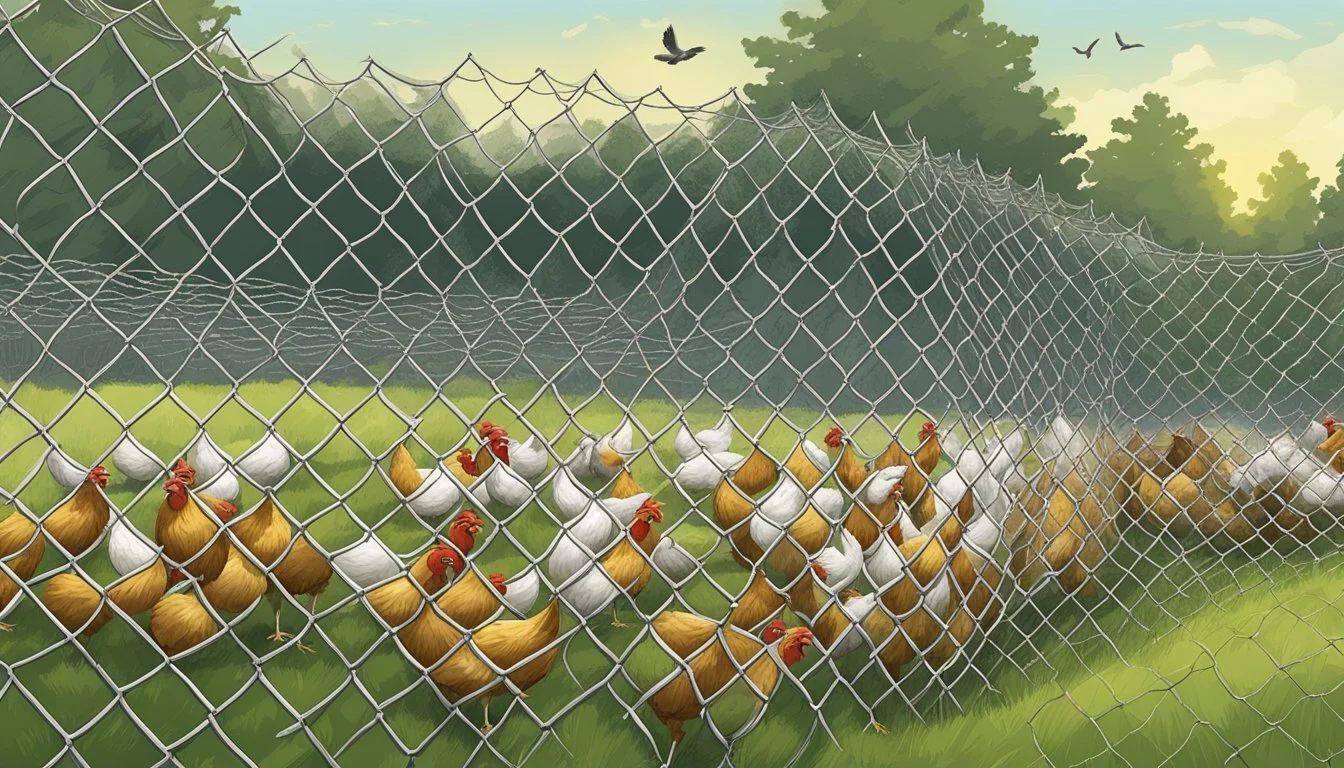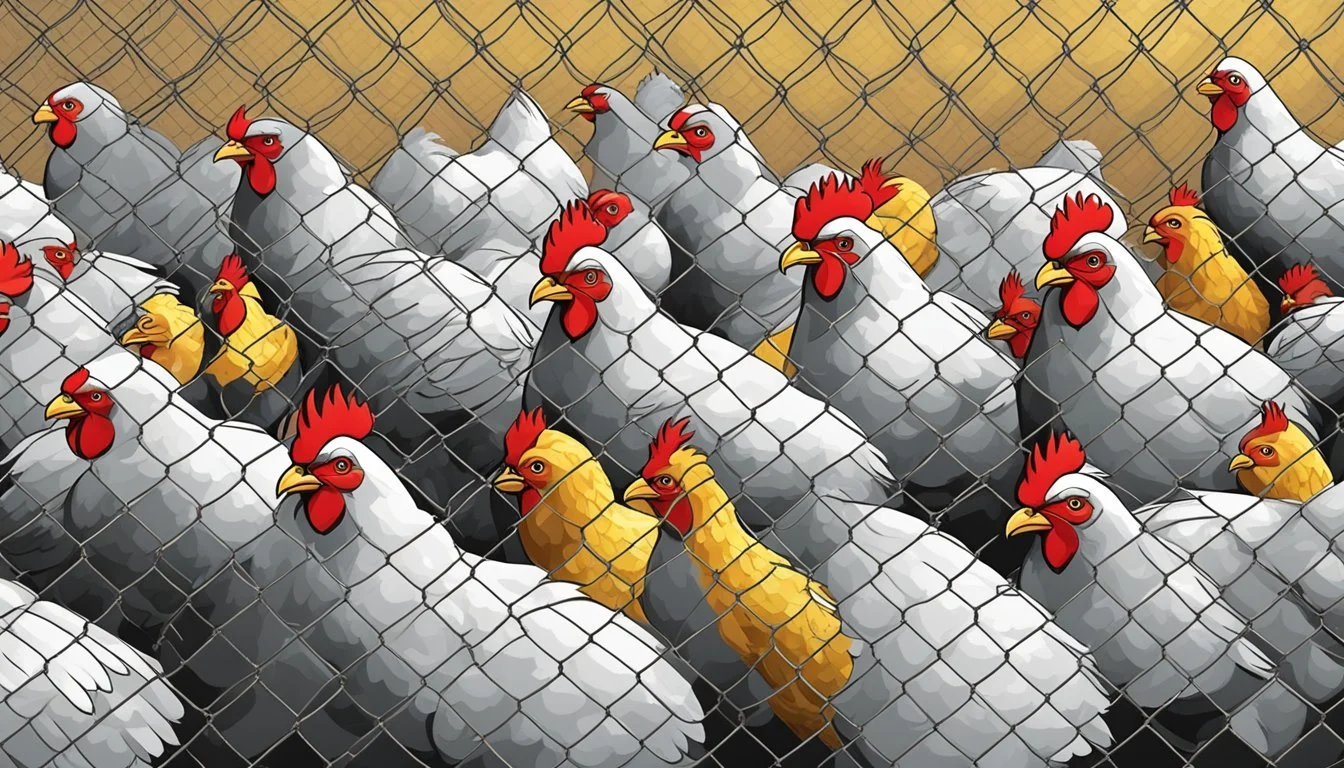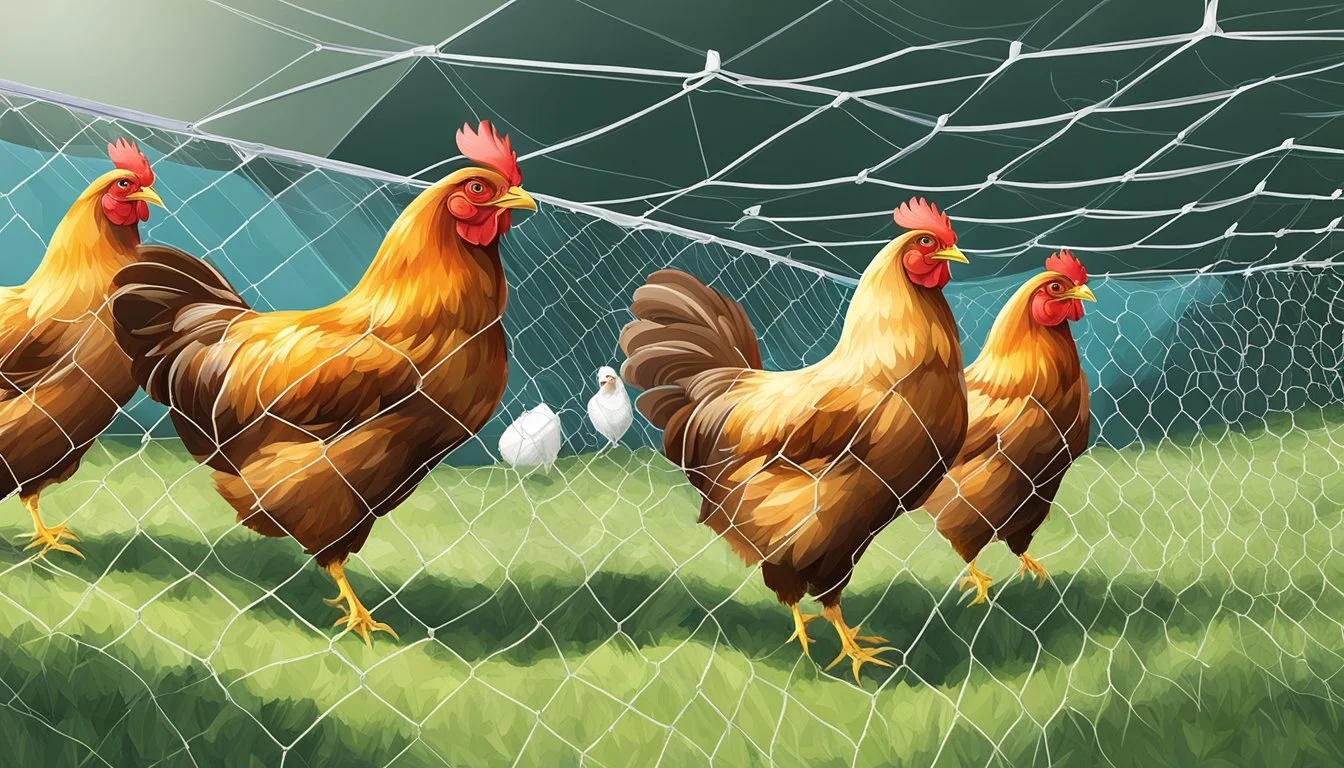Ultimate Guide to Electric Poultry Netting
Secure and Flexible Enclosures for Your Flock
Electric poultry netting offers an efficient solution for those seeking to secure and manage their flock. As a movable barrier, it provides flexibility in pasture management and is particularly effective in protecting poultry from common predators. Unlike traditional fencing, electric poultry netting is designed to deter predators through a safe electric shock, ensuring that chickens are safeguarded within their designated space without harm to any curious intruders.
The features of this netting vary across different products, but typically include ease of installation, portability, and sufficient height to prevent jumping by predators. Some variants also incorporate double-spiked stakes for improved stability, as well as materials such as galvanized steel or polywire mesh to resist wear and corrosion. With the appropriate energizer, such as a solar-powered model, electric poultry netting can be a reliable component of a sustainable and protective poultry management system.
Understanding Electric Poultry Netting
Electric poultry netting is an advanced solution for creating movable and predator-resistant enclosures for poultry. It offers an electrifying deterrent against various types of predators, while providing the flexibility to be set up in various terrains.
Benefits of Electric Poultry Netting
Enhanced Predator Protection: Electric netting provides a psychological barrier and a physical deterrent, greatly reducing the risk of predators such as foxes and raccoons breaching the enclosure.
Portability: This fencing solution is designed for easy setup and relocation, making it ideal for rotational grazing or changing pastures.
Efficiency: The visibly noticeable barrier helps contain poultry and deters them from attempting to escape, maintaining a well-organized space.
Electric Netting vs. Traditional Materials
Electric Poultry Netting
Protection Level: High; active deterrent for predators
Flexibility & Portability: Highly flexible and portable
Installation: Quick and requires minimal tools
Maintenance: Minimal; periodically check for power
Traditional Materials
Protection Level: Moderate; passive barrier only
Flexibility & Portability: Generally fixed and less portable
Installation: Can be labor-intensive and permanent
Maintenance: May need regular repairs
While materials like hardware cloth and chicken wire provide a fixed barrier, they lack the active defense mechanism that electric netting offers. Electric poultry netting adapts to the terrain, with the posts providing necessary support and stability.
Components and Working Principle
The main components of electric poultry netting include:
Conductive Wires: Woven with electrically charged strands to create a deterrent.
Posts: Often made of plastic with metal spikes, they provide structural support.
Electric Fence Charger: Powers the fence, can be solar or mains powered.
The working principle revolves around sending short, safe electrical pulses through the netting. When a predator touches the netting, it completes the electrical circuit, delivering a shock that discourages any further attempt to breach the enclosure.
In essence, electric poultry netting is a modern, effective solution to protect poultry from predators, support ethical poultry management practices, and ensure the ease of managing movable enclosures.
Planning Your Poultry Enclosure
Creating a secure poultry enclosure involves careful planning to protect your birds and ensure their happiness. The layout must take into account the coop and run, consider potential predators, and factor in the ease of moving the setup if it's not stationary.
Choosing the Right Location
When selecting a location for a poultry enclosure, one must consider the terrain, climate, and potential predators. The ideal spot is:
Level ground for stability of the enclosure.
Well-drained to avoid water accumulation.
Sunlight and shade balance to protect chickens from overheating and provide comfort.
Determining the Size and Height
For the enclosure, size and height are crucial for chicken well-being and protection against predators. The guidelines are:
Space: At least 10 square feet per chicken within the run.
Height: A minimum of 40 inches to prevent chickens from flying out and to deter climbing predators.
Incorporating a Coop and Run
The chicken coop serves as a shelter, while the run is an enclosed yard that provides space for free movement. Ensuring their effectiveness involves:
Accessibility: The coop should be easily accessible for cleaning and egg collection.
Security: Strong, tight-knit netting or wiring around the run to prevent predator intrusion.
The coop and run are the heart of the poultry enclosure, and their design should reflect the needs of both the chickens and the caretaker.
Installation Essentials
When setting up electric poultry netting, it is crucial for the owner to ensure that the installation is secure and provides a reliable barrier against predators. The netting should be supported adequately to maintain tension and durability over time.
Setting Up the Electric Netting
For successful installation, the owner must first lay out the electric netting along the desired perimeter. It's important to select a flat area or create a level surface to avoid gaps underneath the netting. Staples can be used to affix the net to wooden posts at regular intervals, ensuring the netting does not sag. If using additional posts, they should be evenly spaced and inserted firmly into the ground. A trench may be dug along the fence line for burying a part of the netting to prevent predators from digging underneath.
Creating a Predator-Proof Barrier
A key attribute of effective poultry netting is its ability to deter predators. To create a predator-proof barrier, the netting must be electrified properly with a reliable fence charger, which should be connected to a grounding system that typically includes at least three ground rods spaced 10 feet apart. The bottom line of the netting should be secured to the ground using stakes, ensuring that there are no gaps for predators to exploit.
Adding Structures for Support
Incorporating robust structures for additional support is critical. For movable pens, lightweight frames can be used to provide stability without hindering mobility. For permanent enclosures, more solid structures like wooden or metal posts should be implemented. Each post must be upright and securely placed into the ground to withstand environmental factors and prevent the net from collapsing or moving.
By paying attention to these installation essentials, owners can establish a movable and predator-resistant poultry enclosure that promotes the safety and well-being of their birds.
Electric Netting Maintenance
To ensure the longevity and effectiveness of electric poultry netting, proper maintenance is crucial. This includes consistent check-ups and timely repair or replacement of damaged parts.
Regular Check-Ups and Testing
Regular inspection of electric poultry netting is essential to maintaining its integrity and functionality. Owners should conduct bi-weekly checks to ensure that:
The electrical current is consistent.
Wires are free of damage and corrosion.
Posts are stable and secure.
Insulators are intact.
To test electrical current, one can use a voltage tester specifically designed for electric fences. It's important to press the tester against the wire and confirm that the charge is within the manufacturer's recommended range.
Repair and Replacement Strategies
When damage is detected during an inspection, prompt repair is necessary. For minor breaks in the wire, a splicing kit can be used to restore continuity. In case of major damage, sections of the netting may need complete replacement. Strategies for repair include:
Using welded wire or hardware cloth for stronger patchwork.
Replacing entire sections if more than 20% of the netting is compromised.
Applying U.V. resistant zip ties for quick fixes to keep netting taut.
When repairing or replacing posts, it's critical to ensure that they are pressed firmly into the ground to maintain the structure's stability. Overall, regular checks and strategic repairs will extend the netting's life and provide reliable protection for poultry.
Adding Security Measures
Effective security measures are critical to protecting poultry from a variety of predators such as raccoons, foxes, coyotes, bears, hawks, weasels, owls, and snakes. These measures can involve the support of guardian animals, the use of physical deterrents, and the implementation of technological solutions and alarms.
Guardian Animals and Physical Deterrents
Guardian animals play a significant role in deterring predators. Livestock guardian dogs, geese, and donkeys can be effective against coyotes, bears, and foxes. They should be properly trained or have a natural instinct to protect the flock.
Physical deterrents include structural improvements like:
Reinforced Locks and Hinges: To prevent clever predators like raccoons, ensure that all enclosure entrances have sturdy locks and hinges.
Predator-Proof Enclosures: Use chain link or electric poultry netting to create an impenetrable barrier. For added security against digging animals, bury the fencing at least 12 inches underground and bend it outward.
Covered Runs: Protect against hawks and owls with overhead netting or wire.
Strong Locks & Hinges: Purpose - Secure coop doors against intelligent predators
Chain Link Fencing: Purpose - Resist tearing by larger animals like bears
Buried & Bent Outward Fencing: Purpose - Prevent digging by foxes, dogs, and coyotes
Overhead Wire or Netting: Purpose - Guard against aerial predators like hawks and owls
Technological Solutions and Alarms
Technological solutions and alarms serve as modern methods to enhance poultry protection. Systems that detect motion can alert owners to the presence of intruders and deter animals.
Alarms: Motion-activated alarms can spook potential predators. Consider installing cameras with night vision to monitor the coop continuously.
Electric Poultry Netting: It delivers a mild shock to predators, acting as an immediate and non-lethal deterrent. Ensure electric netting is kept free of vegetation to maintain effectiveness.
To summarize, integrating guardian animals can naturally reduce predator threats, while physical fortifications like chains and reinforced netting provide a robust barrier. Technological advancements, including motion-activated alarms and electrified netting, add an additional layer of security to safeguard poultry from various threats.
Flock Behavior and Safety
Electric poultry netting stands out as a crucial tool in ensuring the welfare and protection of backyard chickens. By creating a movable barrier, it not only provides defense against predators but also allows the birds the joy of free-ranging in a secured environment, leading to healthier behavior and enhanced egg production.
Ensuring the Health and Happiness of Your Flock
Key factors that contribute to the overall health and happiness of a chicken flock include ample space, access to fresh forage, and protection from predators. Backyard chickens display natural behaviors such as dust bathing, pecking, and foraging when they are in an environment that caters to their physical and psychological needs. Using electric poultry netting ensures these needs are met by providing a secure space that can be adapted to different terrains and relocated as necessary. Livestock guardian dogs can also be integrated to enhance security, making the electric netting a secondary line of defense.
Space Requirements: Chickens need enough space to exhibit natural behaviors. Overcrowding can lead to stress and increased aggression.
Fresh Forage: One of the benefits of free-ranging is access to a diverse diet. Chickens enjoy various greens, insects, and seeds, which contribute to their nutrition.
Predator Defense: Proper setup and maintenance of electric poultry netting are critical to deterring predators such as foxes and dogs.
Managing Free-Ranging Chickens
Free-ranging chickens benefit from the exercise and nutrition available in a less constrained environment, which often leads to higher quality eggs and healthier birds. However, free-ranging also exposes them to risks from predators, pests, and potential escapes. The use of electric poultry netting mitigates these risks while allowing the chickens to roam. It is essential to monitor the setup regularly and check for any damage to the netting that might compromise its effectiveness. Additionally, providing treats within the enclosed area encourages chickens to stay near or within the safe zone created by the netting.
Monitor for Damage: Regular checks can prevent predators from breaching the netting and attacking the flock.
Encourage Homing Behavior: Supplemental treats and a reliable routine help chickens associate safety with their enclosed free-range environment.
Integrate Physical Barriers: Besides electric netting, solid fencing can offer additional protection and discourage potential escapes.
By combining adequate space, attention to behavior, and the installation of a reliable electric poultry netting system, backyard chicken keepers can ensure their flocks lead fulfilling lives while being safe from common suburban and rural predators.
Protecting Against Aerial and Ground Predators
Electric poultry netting serves as a robust barrier against a range of predators, both from the sky and land. Proper installation and maintenance are integral to ensure that poultry is safe from hawks, eagles, and other birds of prey, as well as from digging or climbing predators like coyotes, foxes, and raccoons.
Deterring Birds of Prey
Birds of prey, such as hawks and eagles, pose a significant threat to poultry. Overhead netting or wire can discourage these aerial attackers. The bird netting should be well-anchored and have small mesh sizes to prevent birds from getting tangled and to ensure the safety of your flock.
Material: Durable, UV-resistant material
Mesh Size: Small enough to prevent entry and large enough to avoid tangling
Maintenance: Regular checks for integrity and damage from weather or animals
Preventing Digging and Climbing Intruders
To combat ground-bound predators such as coyotes, foxes, raccoons, bobcats, skunks, rats, and opossums, strong fencing that extends underground is vital. This deters digging predators from breaching the enclosure from below. Additionally, electric tapes or wires should be installed at various heights to ward off climbers.
Dig-Proof Barrier:
Depth: Extend at least 12 inches below the surface
Materials: Heavy-duty mesh or hardware cloth
Climb-Proof Measures:
Number of Wires: Multiple strands at different heights
Electric Charge: Strong enough to deter but not harm the animal
By addressing both aerial and ground threats with specialized measures, poultry owners can create a secure environment for their flocks.
Integrating into Your Garden Ecosystem
Electric poultry netting not only provides security for backyard flocks but also aids in seamlessly integrating chickens into a garden environment. This section explores how to maintain a thriving garden ecosystem by balancing chicken activities with plant life and utilizing chickens for natural pest control and effective composting.
Balancing Chicken Activities with Plant Life
Backyard chickens are beneficial to gardens, but their foraging can harm delicate plants. Chicken keepers should strategically place electric poultry netting to create designated areas that allow chickens to forage without destroying the garden’s landscaping. Designated chicken paths can be created using netting to guide flock movements that protect root systems and prevent overgrazing. Raised garden beds can be a practical solution to protect crops, and lightweight electric netting can secure these areas easily while still allowing chicken access when appropriate.
Key Strategies:
Create designated foraging zones using electric netting.
Protect plants with raised beds or additional barriers.
Allow limited free-range time for chickens to balance their needs with the garden’s health.
Using Chickens for Pest Control and Composting
Chickens offer natural pest control by eating insects, but they also contribute to composting with their droppings. When integrating a backyard flock with electric netting, one can place the netting near compost areas to allow chickens to turn over compost material effectively. By doing so, this not only aids in pest reduction but also accelerates the composting process, providing excellent fertilizer for the garden.
Benefits:
Natural pest management: Chickens reduce garden pests without the need for harsh chemicals.
Enhanced composting: Chicken droppings are rich in nitrogen, aiding in the breakdown of organic waste.
Incorporating chickens into a garden ecosystem with electric poultry netting protects both poultry and plants, establishes a sustainable cycle of foraging, pest control, and composting, and contributes to a holistic backyard environment.
Advanced Topics and Innovations
In the realm of poultry farming, embracing advanced technologies significantly enhances the efficiency of electric poultry netting systems. Innovations such as solar power and automation are pivotal in optimizing the management and safety of poultry enclosures.
Solar-Powered Electric Systems
Solar-powered electric systems offer an eco-friendly and efficient solution for powering poultry netting. These systems harness solar energy through photovoltaic panels, converting it into electrical energy to maintain a consistent electric charge in the netting. The integration of solar technology eliminates the need for traditional electricity sources, thereby reducing operational costs and enhancing the portability of poultry enclosures. Not only do they contribute to sustainable farming practices, but they also ensure that the netting remains functional in remote or off-grid locations.
Key Features of Solar-Powered Electric Systems:
Energy Efficiency: Utilization of renewable solar energy.
Cost-Effectiveness: Minimizes reliance on external power sources, cutting down on electricity bills.
Portability: Facilitates easy relocation of poultry enclosures without the constraint of proximity to power outlets.
Automation in Chicken Coops
Automation technology has revolutionized the management of chicken coops, improving both productivity and security. Automated doors, for example, are programmed to open and close at specific times, which optimizes the chicken's routine while keeping predators at bay. These doors often integrate with the electric poultry netting systems to provide a fully secure environment. They can also be connected to sensors or timers to further streamline the poultry management process.
Benefits of Implementing Automation:
Enhanced Security: Automated doors deter predators and protect the flock.
Time-Saving: Reduces the labor required for daily coop operations.
Regulated Schedules: Maintains consistent opening and closing routines aligned with daylight hours.
By incorporating these advanced tech solutions, poultry farmers can improve the productivity and safety of their electric poultry netting setups, leading to a more efficient and sustainable operation.
Conclusion
Electric poultry netting offers a dynamic and reliable approach to securing poultry. Its mobility and effectiveness against predators are proven assets for any poultry keeper. Looking ahead, the future prospects for these enclosures are promising, as they blend convenience with robust protection.
Summary of Benefits:
Mobility: Easily repositionable to manage land and flock health.
Predator Resistance: Strong deterrent against common threats such as foxes and raccoons.
Ease of Installation: Kits come with preinstalled posts for user-friendly setup.
As poultry enthusiasts continue to seek optimal solutions for their flocks, electric netting stands out for its practicality and safety advantages. It is a testament to advancing agricultural technologies, adapting classic methods to modern needs.
With continued innovation and feedback from users, improvement in durability and functionality of these netting systems can be anticipated. The poultry community should remain informed on best practices and emerging products to ensure the well-being of their flocks. Electric poultry netting is a protective measure that resonates with the needs of the present and is adaptable for the future.





